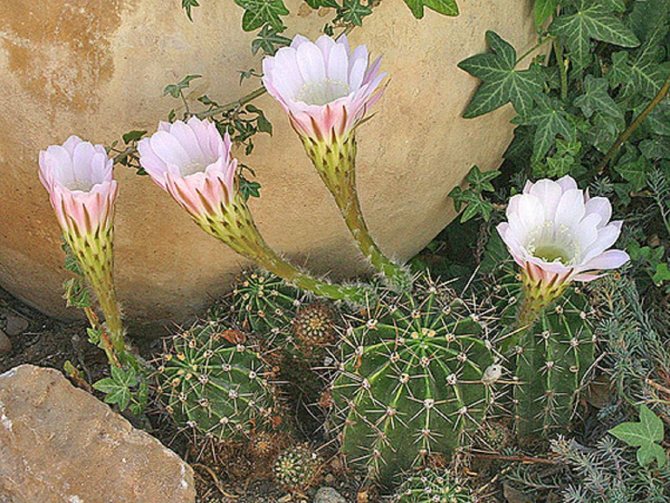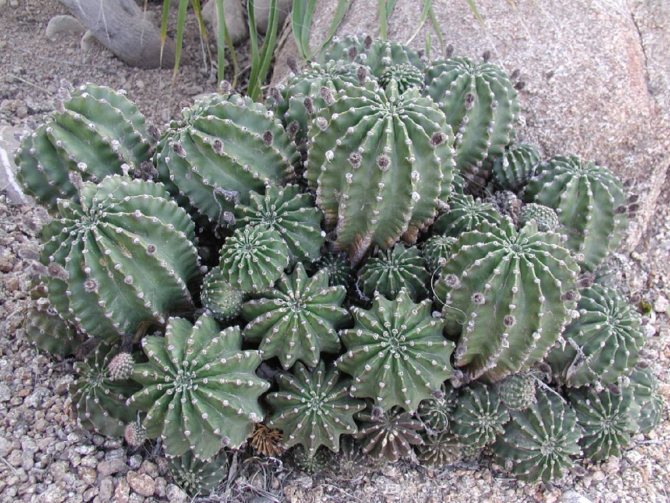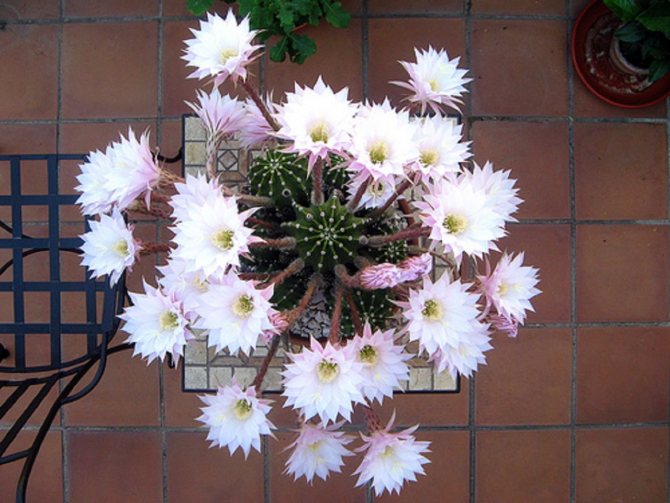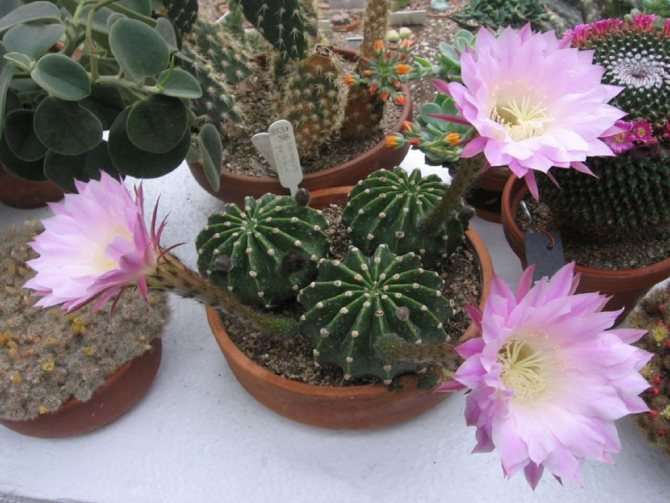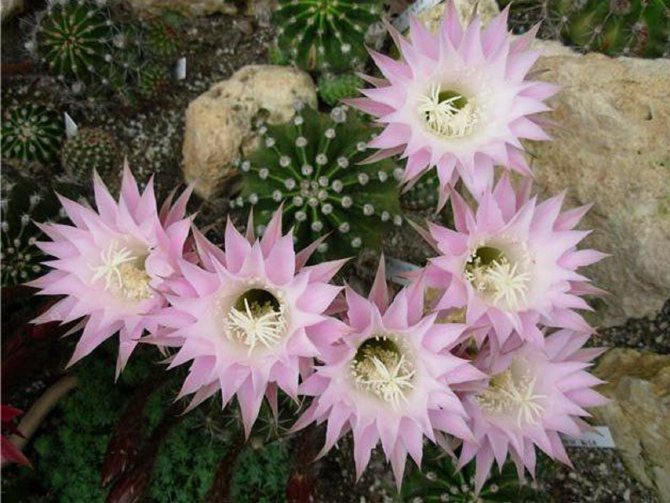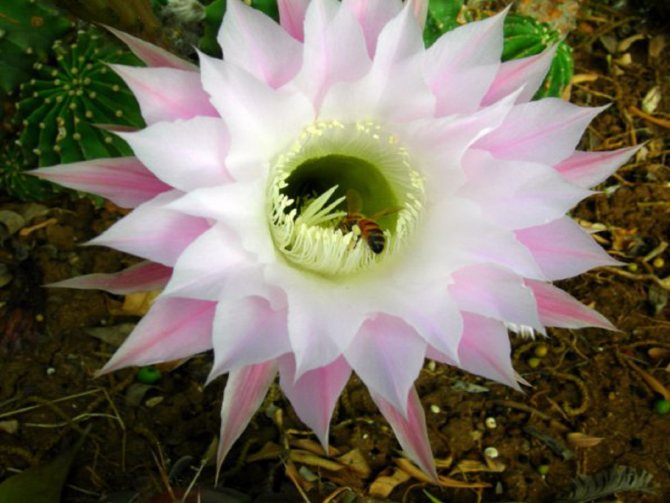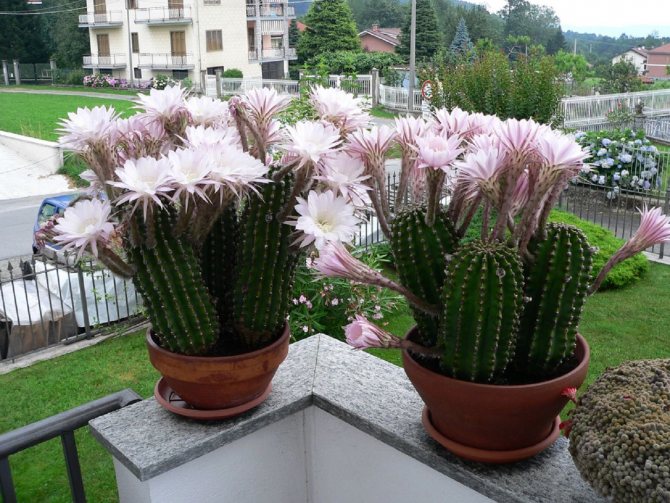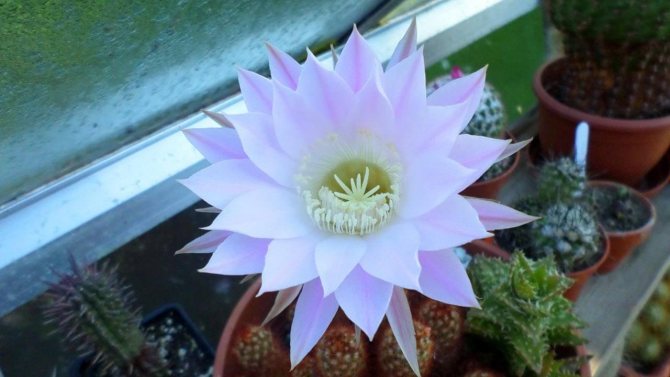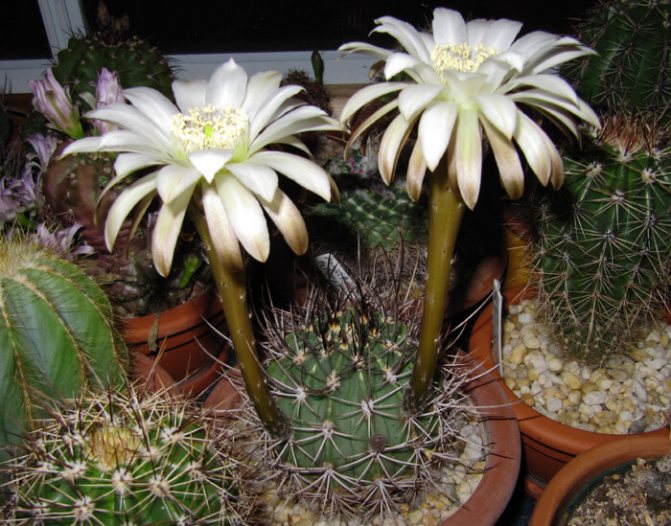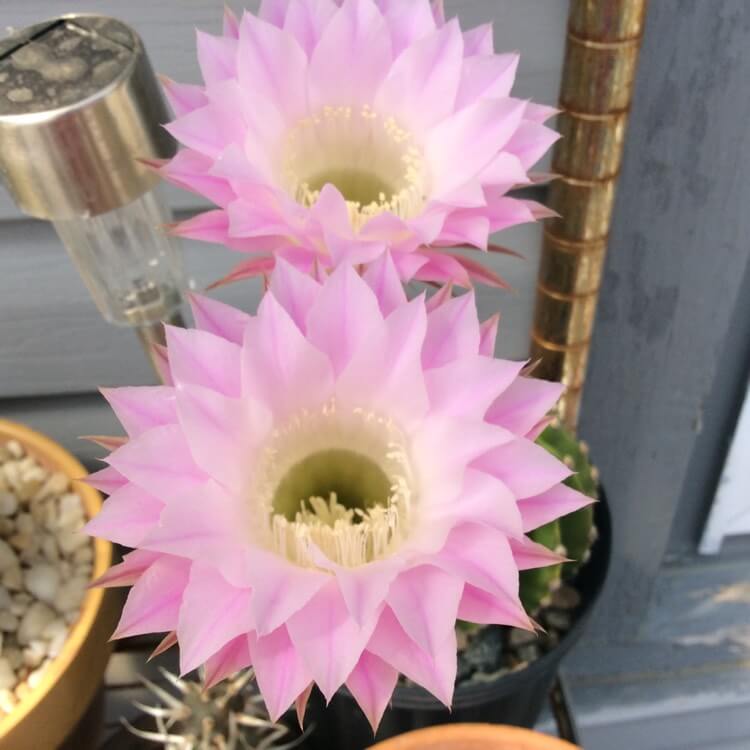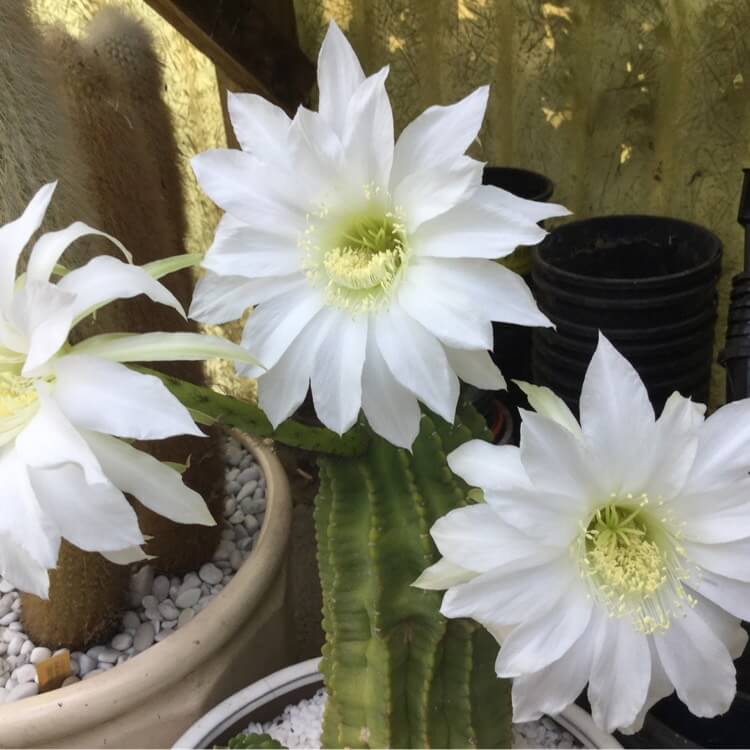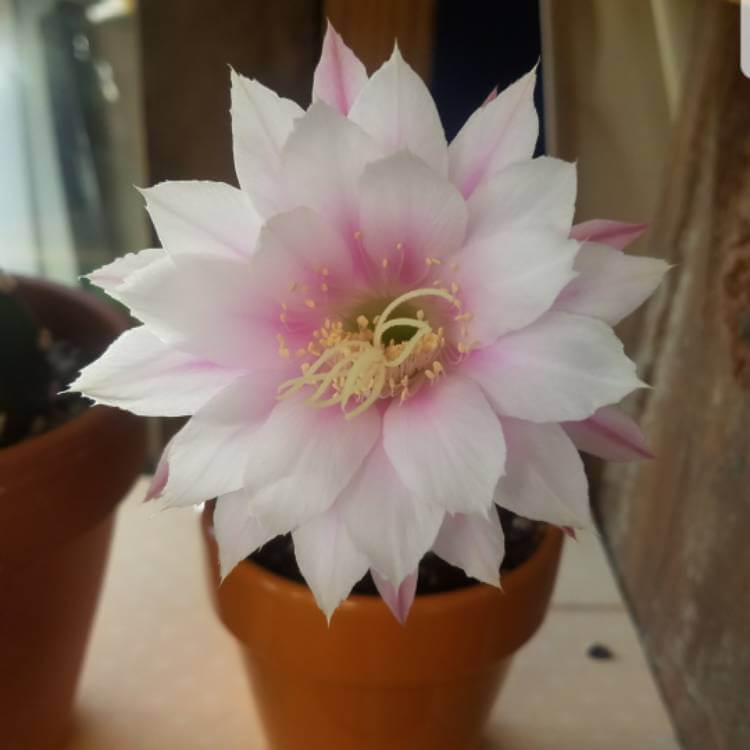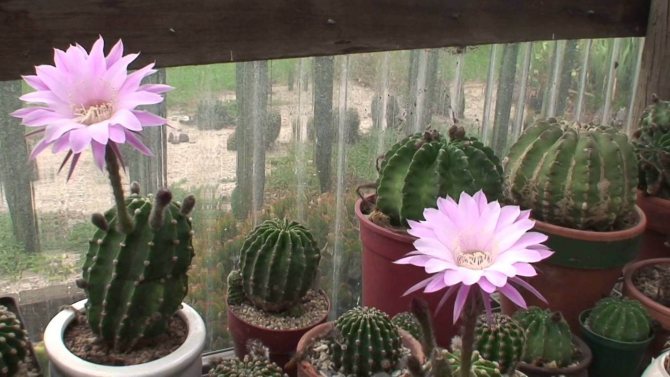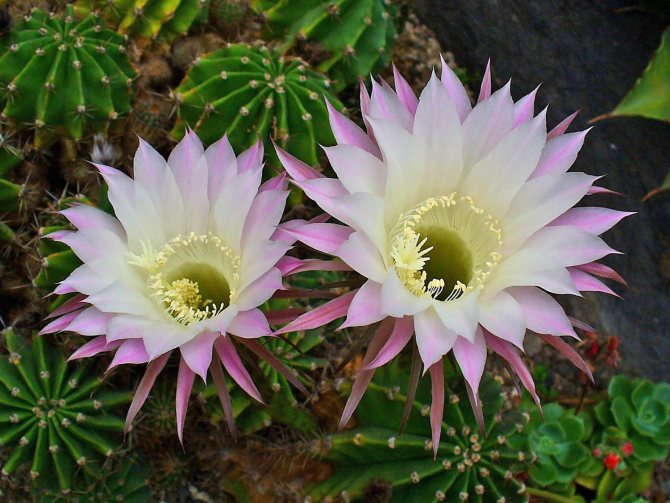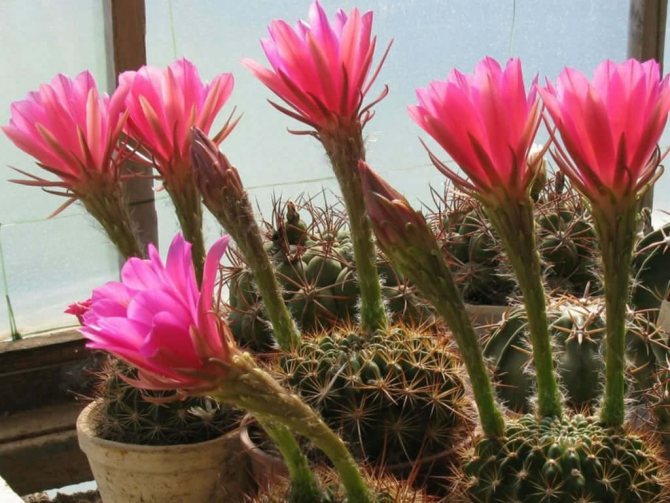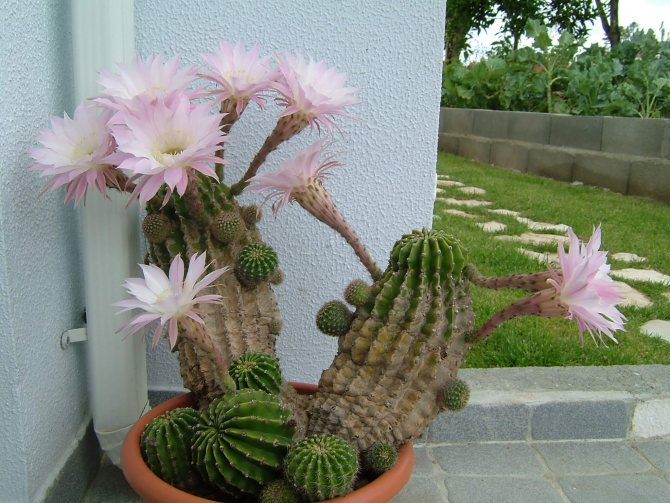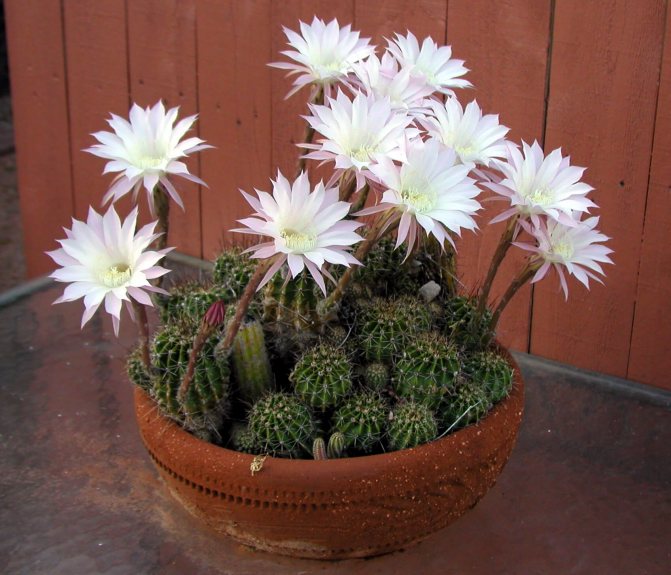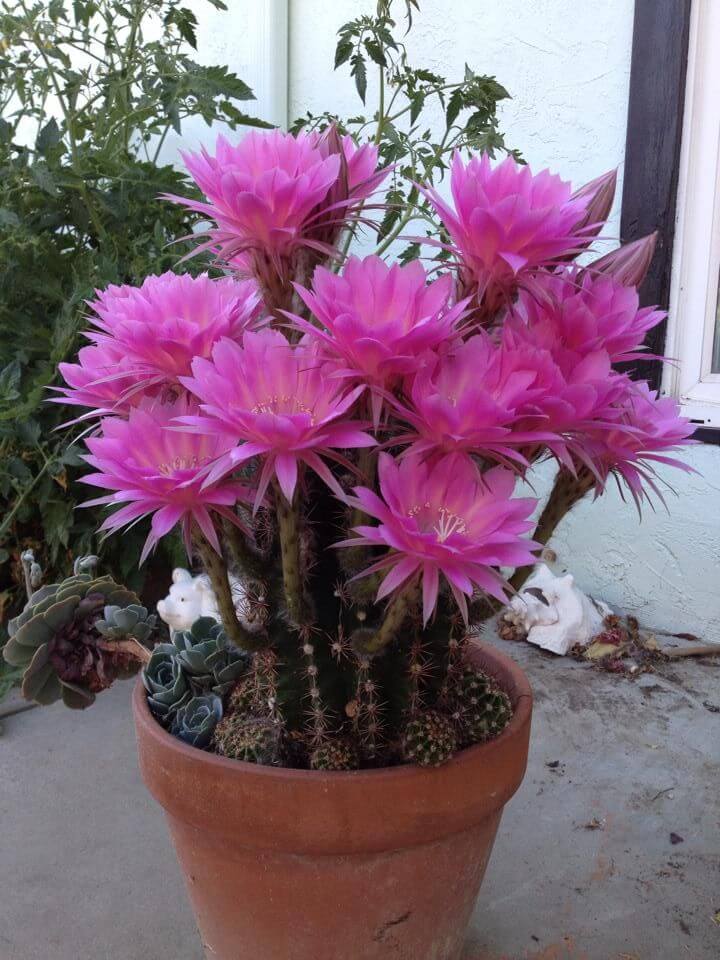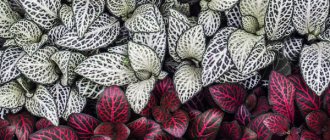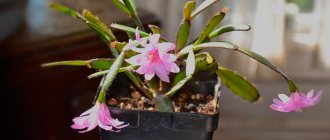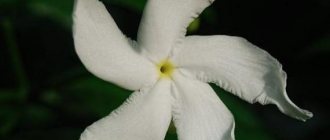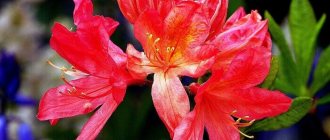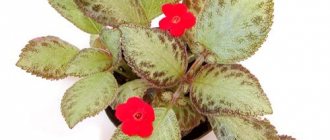Unusual, sometimes a little strange and at the same time regally magnificent representatives of the Cactus family appeared in Europe in the first year of the 18th century.
The special appearance and unpretentiousness of the emissaries of South America attracted the attention of flower growers and contributed to their widespread distribution - various types of cacti could be meet in greenhouses and botanical gardens many European cities.
And soon they took the best places in private collections of lovers of tropical plants and on the windowsills of ordinary houses.
Botanical description and birthplace of the plant
Echinopsis is a slow-growing perennial plant of the Cactaceae family. It has been grown in Europe since 1700. Representatives of the genus (about 130 species) grow in countries: from Bolivia to Argentina, are found in Brazil and Uruguay, in the valleys and foothills of the Andes.
Translated from Latin, the name of the plant means hedgehog.
The rhizome is powerful, but located horizontally close to the soil surface. A spherical stem comes out, which over time can be extended by an erect column above a person's height or droop to the ground. They grow in whole groups, occupying a vast area. Lateral processes on the stems rarely appear.
The stem is divided into several pronounced ribs; pubescent halos are located on their crests, spines are small, straight or curved. Skin from light green to dark shade, can be matte or glossy.
Echinopsis is unpretentious in leaving. Like most cacti, it needs bright lighting, a warm growing season with additional fertilizing and moderate watering, and a cool wintering contributes to the establishment of flower buds.
Echinopsis bloom
Florists are very fond of these "hedgehogs", referring to Echinopsis as a viable and regularly blooming cactus.
Depending on the age, up to 25 buds bloom on one plant. They are located on the sides, attached with a scaly process about 20 cm long. Narrow petals with a pointed top form several rows, the core is decorated with a ring of stamens. A shade of flowers in delicate white-pink-purple, reddish, yellow tones. The flowering period is in the spring.
Popular varieties
128 species of Echinopsis have been discovered. Not all varieties are suitable for growing in an apartment. The most popular varieties include:
- Echinopsis golden. Blooms with yellow flowers. The spines of mature plants acquire a golden hue. The cactus is small - no more than 15 cm. The shortened flower tube is about 10 cm.
- Echinopsis Erie. Miniature form up to 25 cm, in diameter - no more than 10 cm. Flowers are white, exude a pleasant aroma, bloom at night. The cultivar is named for the French cactus grower.
- Echinopsis cinnabar red. The size is medium, the shape is slightly flattened. Flowers have a shade corresponding to the name.
- Echinopsis Gertrich. Diameter no more than 10 cm. The spines are dense, spread apart. The flowers are large, with a deep red hue.
- Echinopsis is sharp-edged. Blooms easily. Flowers are white, fragrant, bloom at night. With age, the thorns fall off, the body of the cactus becomes smooth.
Interesting fact! The height of common varieties usually does not exceed 30 cm. Some species can grow up to 70 cm.In nature, there are specimens of human height.
Growing conditions
Illumination
The most suitable place for light-loving echinopsis is the southern windowsill, since the "prickly hedgehog" is not afraid of direct sunlight. You need bright lighting throughout the year, turn on fluorescent lamps in winter, placing them 50 cm above the plant. During the period of active growth, it is advisable not to turn the cactus immediately and put it in a suitable place.
Air temperature
In spring and summer, keep at a temperature not lower than 20 ° C. It is preferable to spend the summer season for the plant in the fresh air: take it to the veranda, balcony, where the echinopsis will bask in the bright rays of the sun and be blown by the breeze. From the second half of autumn to February, it stays in a dormant stage, and therefore, it is desirable to maintain the temperature at 8-9 ° C. Avoid drafts and make sure that the plant does not freeze.
general information
Echinopsis is a genus of succulents belonging to the Cactaceae family. Its name comes from the Greek "echinus" - hedgehog and "opsis" - similar. This name, which Karl Linnaeus suggested back in the 30s of the 18th century, is very suitable for plants, since, due to the abundance of thorns and a spherical shape, they really look like hedgehogs curled up into balls.
It is interesting! Recently, the Echinopsis genus has significantly replenished, it included Acantolobivia, Lobivia, Hamecereus and some other genera that were previously considered independent.
The range of Echinopsis extends from northern Bolivia to southern Argentina. They are also found in the flora of Uruguay and Southern Brazil. They grow in the Andes, in the valleys and outskirts of mountain ranges.
Echinopsis have gained immense popularity in indoor floriculture. In European countries, they have been grown from about the end of the 16th - beginning of the 17th century. Representatives of the genus have been participating in cultural breeding since 1837, and today they have managed to obtain a large number of hybrid forms that differ in color.
Echinopsis hybrids are also common among florists, like zygocactus. At the same time, they not only do not lose popularity, but also continue to interest both cactus growers and breeders.

How to care for echinopsis at home


Watering
Water the Echinopsis during the period of active growth. Use filtered, thawed, rain or settled tap water, at room temperature. Between waterings, the earthen lump should dry out to half or more. With a decrease in temperature during rest, stop moistening the soil.
Air humidity
The dryness of the indoor air will not interfere with the normal development of the plant. For hygiene purposes only, bathe your cactus in a warm shower in the summer. Cover the top of the soil with a bag to keep the substrate from getting wet. After the procedure, let it dry in the shade and only then expose it to the rays of the sun.
Top dressing
In nature, a cactus grows on depleted soils, so overfeeding the plant is harmful. Only during the period of active growth it is allowed to apply once a month special fertilizers for cacti and succulents.
Wintering
Echinopsis requires a cool, dry maintenance during the winter months for flower buds to form. Place the plant in a cool, well-lit area during the winter, and reduce watering by slightly moistening the ground no more than once a month. In the spring, when daylight hours increase, return the plant to a warm room and gradually resume watering. As soon as you see signs of awakening, feed the first time with a comprehensive cactus feed.
Use in decorative floriculture


Plant type
: blooming. For the best flowering, it is recommended to keep the plant in one position at all times without turning.
Decorative period
: May June.Echinopsis sharp-edged usually forms groups, that is, there are many processes.
Appointment
: used for rock compositions and creating a semi-desert landscape, for decorating rooms with artificial light
.
Agrotechnics
The soil
: a mixture of leaf and sod land, humus, weathered clay, coarse sand (1.5: 1: 1: 1: 1), add a little broken brick.
Care
: does not like spacious dishes and deep planting; the stems of very old plants rejuvenate; a cold and dry wintering is necessary (a period without watering from October to April) at 10 degrees Celsius.
Watering
: regular, drying out of the earthen coma or excessive watering causes the buds to fall off.
Top dressing
: only for large cacti (age 5 and more years) in the summer with mineral dressing (1-1, 5 g of complete fertilizer per 1 liter of water).
Lighting
: bright, sunny side.
Reproduction
: seeds and lateral shoots "babies" in spring or summer.
Possible problems
: when choosing a location, it is not recommended to rearrange and turn the plants towards the light source, as this leads to the dropping of the buds.
How to transplant echinopsis
Initially, choose a medium-deep, wide, stable pot for growing Echinopsis. It will be necessary to repot the plant as needed: when the roots begin to show through the drainage holes or the aerial part (the main stem with basal shoots) will cover the soil surface.
Cover the bottom with a 3-4 cm layer of drainage (broken brick, pebbles, expanded clay, pieces of foam or a mixture of components). Add some soil and transfer the echinopsis along with the earthen clod. In order not to get hurt by thorns, put on tight gloves, and wrap the stem of the plant with a layer of newspaper.
The soil is needed loose, light, permeable to air and water, neutral reaction. The easiest way is to purchase a universal substrate for succulents and cacti at a flower shop. For self-preparation of the soil mixture, you will need 2 parts of sod land, 1 part each of leaf humus and coarse-grained river sand, 0.5 parts of fine gravel and some charcoal.
How to propagate indoor echinopsis?
There are several methods for this, and each has a number of advantages:
- Seed material
The seeds are soaked in warm water for 3-4 hours, and then treated with a solution of potassium permanganate. They should be spread out on the surface of a moistened soil mixture, slightly deepening, and cover the container with polyethylene or glass.
The covering material is removed after the sprouts appear. Seedlings are transplanted into separate cups when the first spines form and the root system develops well.
- Children
The simplest and most effective method that growers resort to more often. The required number of children is cut off, they are slightly dried and placed in moist soil. Sticks or pebbles can be used as support to keep them upright and not fall off.
Water the shoots as needed, avoiding waterlogging of the soil. When the “hedgehog babies” have 10-15 mm roots, they can be transplanted.
Echinopsis are often used for rootstocks, but the event is successful only if the layers of the cambium of the two specimens match as closely as possible. By this method, it is possible to cross "hedgehogs" of various species. The graft is cut and rooted when it gets stronger, but it is not recommended to keep it on a rootstock for longer than 1-2 years.


Echinopsis from seeds at home
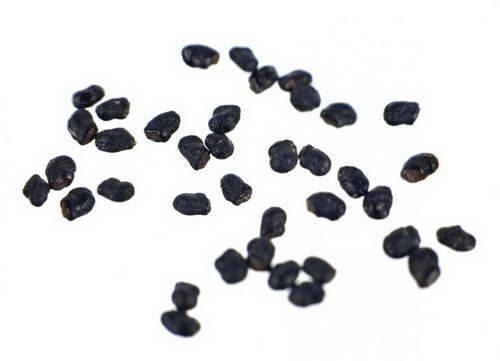

Echinopsis seeds photo
Generative (seed) reproduction of Echinopsis is rarely practiced, since the plant produces many basal shoots. But plants obtained from seeds do better. Sow seeds in spring, after soaking them in warm water for a day.
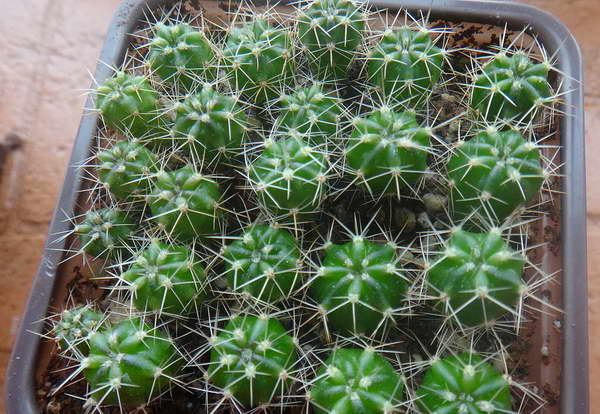

Echinopsis from seeds photo of seedlings
- Prepare bowls with drainage holes, pour a mixture of leaf humus, coarse sand and charcoal, prepared in an equal proportion of parts, distribute the seeds over the surface and spray with warm water from a fine spray.
- Cover crops with glass or a transparent bag, do not forget about daily ventilation.
- Lighting is necessary diffused, and the temperature is within 20-22 ° C, as the soil dries up, spray again.
- Friendly entrances will appear in 15-20 days, thin out with tweezers.
- When the seedlings grow up, transfer them into separate pots.
Echinopsis on postage stamps
Echinopsis sharp-edged on a postage stamp of the GDR (1974) (Michel # 1922)
In February 1974, the GDR post issued a series of six stamps depicting cacti. One of the stamps in the series (Michel # 1922) depicts sharp-edged echinopsis
.
The Post of Monaco placed the image of Echinopsis sharp-edged on the final stamp (Michel # 1511) of the "Exotic Plants" series, published in December 1981, as well as on the first stamp (Michel # 2122) of the "Cacti from the Botanical Garden of Monaco" series, published in May 1993
.
The Mongolian Post has dedicated one of the stamps (Scott # 1744) of the September 1989 series to Echinopsis Ostroglyn.
.
Vegetative propagation of echinopsis
Separate the scions from the parent plant in the spring. How to properly separate cactus from echinopsis? Put on gloves and gently rotate the baby around the axis, the shoot will easily break away from the mother plant without unnecessary harm.
- Sprinkle wood ashes on the parent plant and the young growth.
- Plant the kids in wet sand.
- The shoots may fall, since they do not yet have roots, and it is not necessary to deepen into the soil very much - to fix it, prop the seedlings with a match or an ice cream stick.
- Cover the top with a clear lid, plastic cup or bag, but ventilate every day.
- Provide the plants with diffused lighting and an air temperature of 20-22 ° C, water through a pan or in small portions of water along the edges of the container.
- The roots will appear after 2 weeks, later the rooted seedlings can be transferred into a pot with soil for adult plants.
Breeding technique
There are two ways of reproduction - rooting babies and sowing seeds. Both methods are successfully practiced by flower growers.
- Children. Children are separated, dried during the day. The landing container is filled with wet sand. Children are lightly pressed into the sand. It is not necessary to cover with foil. Keep in a warm place, periodically moisten the sand. Babies take root in 1-2 weeks. The grown plants are transplanted into small pots.
- Seeds. Sowing begins in March. Sand is poured into a bowl, moistened. The seeds are soaked for a couple of hours in a weak solution of potassium permanganate (slightly pink), laid out on the surface of the sand. No need to sprinkle. The container is covered with foil and kept at 20 ° C. Every day the film is lifted, the greenhouse is ventilated. Shoots appear in 2-3 weeks. They do not dive right away - they wait until the seedlings grow a little and get stronger.
Advice! A very old plant can be rejuvenated. The top is cut off with a sharp knife, and left at room temperature in a shaded place for 10 days. Wet sand is poured into the pot, the dried top is placed in it. In 1-2 weeks, it will take root. On the remaining hemp, young shoots will also go.
Pests and diseases
The worst enemy of any cactus is waterlogging. The root system is affected by rot and the plant begins to die. You can try to save the plant with an emergency transplant, in which rotten roots are cut off, the sections and container are disinfected, and the substrate is replaced with fresh one. If the stem has turned into a jelly-like mass with a white bloom, attempts are in vain and you can say goodbye to echinocactus.
Rarely, echinocactum can infect a spider mite. It is a dark red rounded beetle. It feeds on plant sap, dark specks remain on the surface of the skin from its bites, and the secretions of the pest are like threads of a cobweb.Moisten a cotton pad with soapy water and wipe the stem, bathe in a warm shower after 30 minutes. If it does not help, resort to spraying with acaricide (for example, Fitoverm drug).
Why doesn't a succulent bloom?
Echinopsis are resistant to all kinds of changes, however, the cactus reacts to significant violations, including the absence of flowering. There are several main reasons for this:
- Lack of cold wintering.
- Lack of light.
- Prolonged droughts.
- Excessive fertilization.
- The formation of a large number of children.
- The container is too large.
- The defeat of the succulent by insect pests.
- Turning or moving the flower pot while laying the buds, he simply discards them.
You can solve the problem with flowering by identifying the violation and eliminating it. Echinopsis usually respond gratefully to positive changes.
Care problems
Echinopsis does not bloom
Echinopsis does not bloom - growers who do not know about the need for a cool winter complain about this. Remember: if you want to see the lush flowering of a handsome man, keep it in winter at a temperature of 16-18 ° C and do not water it (no more than once a month). Insufficient lighting can also be the reason for the lack of flowering.
Echinopsis covered with a brown crust
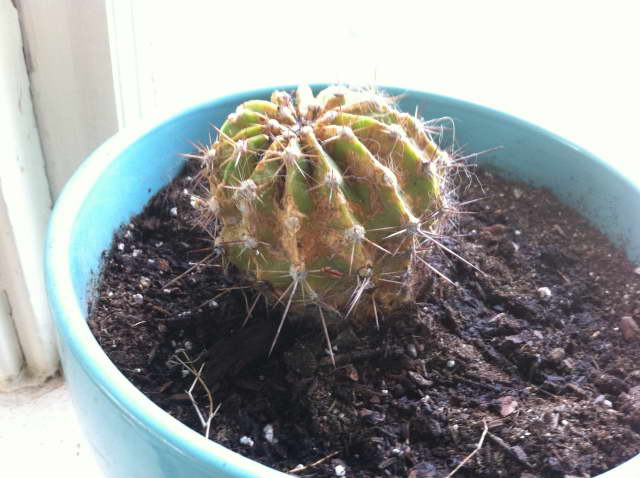

Echinopsis covered with a brown crust photo
The change from a pale green skin to a rough brown one looks very ugly. A similar problem occurs when a plant gets sunburn. This is possible if the plant was kept on the northern windowsill, and then suddenly received a lot of hot sun. It is impossible to eliminate the defect, the only way out is to wait for the appearance of the children and propagate the cactus, growing new beautiful plants. To prevent the problem from recurring, train the cacti to change the lighting gradually.
Sometimes pests can become the cause of the problem, then treatment with a systemic insecticide is required. Protective reactions in the form of coarseness of the skin also occur during starvation of a cactus, if it was grown for a long time in one pot without transplanting and feeding. The problem of starvation can also arise with overly compressed soil: you continue to water, but the roots of the plant do not receive moisture with nutrients, since it passes into the pan along the edge of the pot and does not penetrate deep into the earthen coma. The way out is to transplant the plant into the soil for cacti, a mandatory drainage device at the bottom of the pot.
How to make Echinopsis bloom
The lack of flowering in cacti is not so rare. And the problem is caused primarily by non-compliance with the temperature regime. Cacti need to get optimal temperatures in the summer months and a cool dormant period in the winter - and bloom is sure to take place.
The cactus may not bloom when low light, frequent watering and root rot - in any case, diagnose and eliminate the causes of the problem.
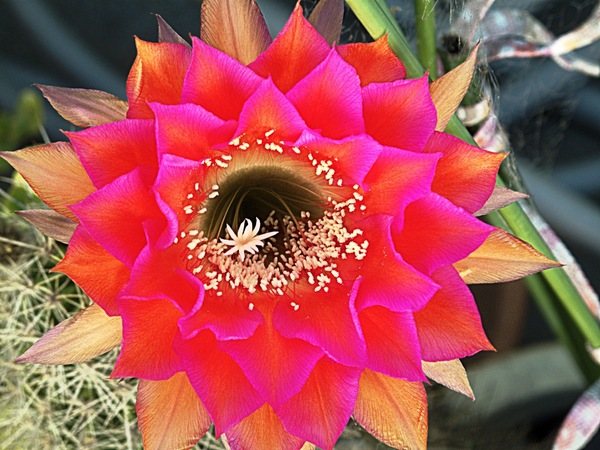

Types of echinopsis with photos and descriptions
Echinopsis echinopsis subdenudata or semi-nude Echinopsis subdenudata
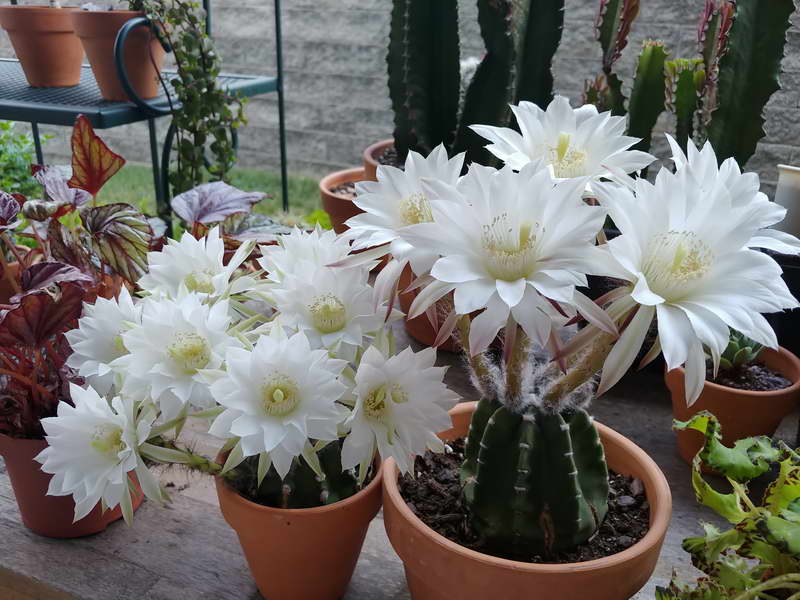

A small plant with a spherical stem. There are not many ribs, they resemble mandarin lobes. The color is large, snow-white.
Description: Echinopsis subdenudata is a globular, almost spineless or very short creamy spine cactus that produces gorgeous nocturnal, white, fragrant flowers up to 22 cm long.It is usually included in (as a synonym) Echinopsis ancistrophora, which indicates that there is no fundamental difference between them. The key difference by which this species was distinguished: its much shorter spines (less than 2 mm long), almost hidden among the felt areoles, appear to fall within the natural variation of Echinopsis ancistrophora and should be synonymous with the latter. It is, for the most part, a variety of Echinopsis ancistrophora, but it still has value to the collector as they identify individual plants with certain characteristics.
Stem: single or displaced from the base, globular, gray-green, depressed at the apex, 5-8 cm in height, 7-12 cm in diameter (often elongated and up to 30 cm in height when grown) Ribs: 8 to 12, very sharp slightly serrated. Areoles: small, cream-colored, transversely elliptical, up to 1.5 cm apart. Spines: Almost spineless or with very short creamy or greyish brown spines, often hidden by areolar pubescence. One central spine, directed upwards, up to 2 mm long. Radial spines: 3-7, pubescent, generally up to 1.5 mm in length. Flowers: These cacti produce gorgeous nocturnal flowers that grow near the tips of the stems. They are fragrant, white (or very light pink), narrow funnel-shaped, with long, slightly curved tubes 15-22 cm long. An old plant can have many flowers at the same time. Bloom season: This species blooms from late spring to late summer, flowers open in the morning of the first day and remain open all night, but in full beauty they last only one day, on the second day they begin to fade.
Echinopsis Echinopsis Echinopsis eyriesii
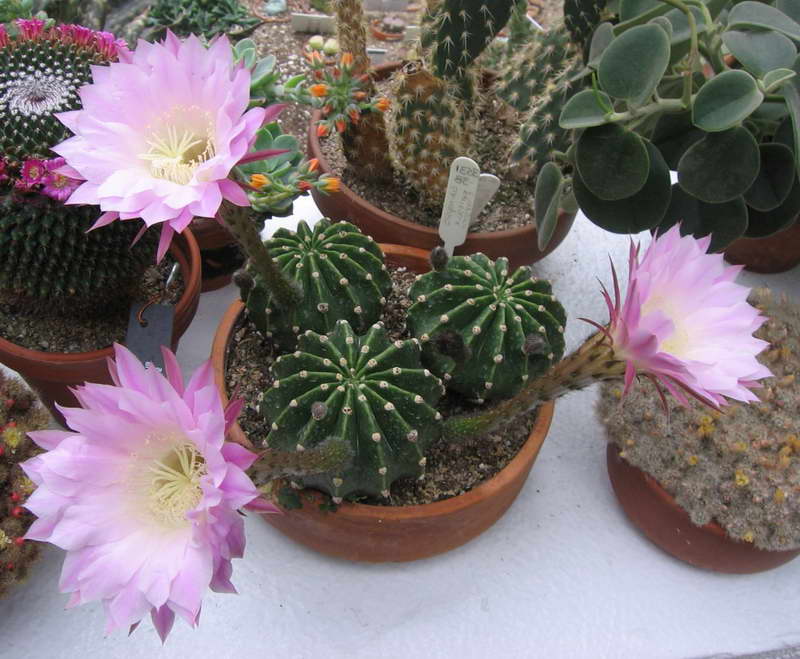

Spherical echinopsis, the stem is divided into 18 faces. The skin is dark green, the halos are covered with tomentose pubescence, the needles are short. Petals are white or pale lilac.
Description: Echinopsis eyriesii is a very popular large cactus widely grown for its huge nighttime flowers. It is the most famous and most commonly grown globular cactus. Shape: simple or (usually) clustered, mostly branched. Over time, it can form extremely large mounds up to 1.5 m high and 2-3 m wide. Root: Fibrous.
Stem: spherical, later elongated and almost cylindrical, 15-30 cm high, 12-15 cm thick, dark green and strongly ribbed. Ribs: 9 to 18, well sprung, rather thin above. Areoles: round, filled with white or yellowish pubescence, spaced up to 1 cm apart. Spines: several, from 14 to 18, very short. Radial spines: Thin, 5-10 mm long, often absent in mature plants. Central spines: 4-8 thick, conical, less than 5 mm in height, hard, blackish. Young plants and shoots initially have longer and weaker spines, thick short conical spines appear only later.
Flower: nocturnal, pure white or pinkish, pale purple, very large, appears above the middle of the plant, 17 to 25 cm long, 5-10 cm in diameter (the presence of pink shades in the flower indicates hybridization). The flower tube is funnel-shaped with a rounded lower part, then narrow and curved in different ways and gradually expanding into the crown, dark green, covered with small ovoid brownish scales and dark gray or black hairs. The lower outer perianth segments are rather linear and greenish; the inner perianth segments are wide and white, pointed. The throat is greenish, with several stamens along the inner perimeter. Stamens are shorter than perianth segments. The flowers are highly fragrant.
Bloom Season: Flowers appear from spring to summer over several nights. In sunny weather the next day they disappear, but in cold rainy weather they can last two, rarely three days.
Fruits: up to 5 cm long, green, covered with hairs and containing a large number of black seeds.
Echinopsis mamylosa Echinopsis mamillosa


The stem is rounded, divided into 13-18 tuberous ribs. The needles are about 1 cm long, yellowish. The flowers are deep pink, red or white.
Description: A single spherical or columnar cactus with a diameter of 10-25 cm and a height of 7-30 cm or more, depending on the variety. Stem: Large and spherical, with many ribs divided into low, rounded tubercles. Flowers: up to 20 cm long, 10 cm wide. Flowering season: This species will expel flowers in summer when the plant itself is only 8 cm in diameter. Flowers open at night and last for about 24 hours.Notes: Echinopsis mammillosa is often used in hybridization and is an important component of some modern Echinopsis hybrids, providing these hybrids with a large showy floral structure.
Echinopsis white-flowered Echinopsis leucantha


As it matures, the stem acquires the shape of a cylinder. Obtuse ribs, including 12-14 pieces. The skin is green with a gray tint. The spines are long, dark brown. The flowers are snow-white.
Description: Stems: spherical to elongated, grayish-green to brownish, about 15-35 cm high and 10-15 cm in diameter, eventually becoming cylindrical up to 1.5 m in height, usually simple or deviating from about 10 cm. Ribs: 10 to 14, straight, somewhat tight. Areoles: close together, oblong. Radial spines: 7-8, up to 2 cm long, more or less curved, brownish. Central spine: 1, directed upward, curved and sometimes almost hooked, elongated, often 10 cm long, dark brown. Flowers: white or pale pink, tubular, about 16 cm long; tube about 3 cm wide in the mouth, dark brown, with scattered areoles with small tufts of brown hairs; outer perianth segments brownish, spreading, 2 cm long, with a sharp scarred tip; inner perianth segments about 3 rows, widening, outer purple, inner almost white, oblong, sharp, about 3 cm long; stamens in several rows of different lengths, without a separate throat circle, rows at the mouth of the flower tube are straight, 1.5 cm long; stigmas are numerous, green. Blooming season: spring-summer.
Echinopsis golden Echinopsis aurea
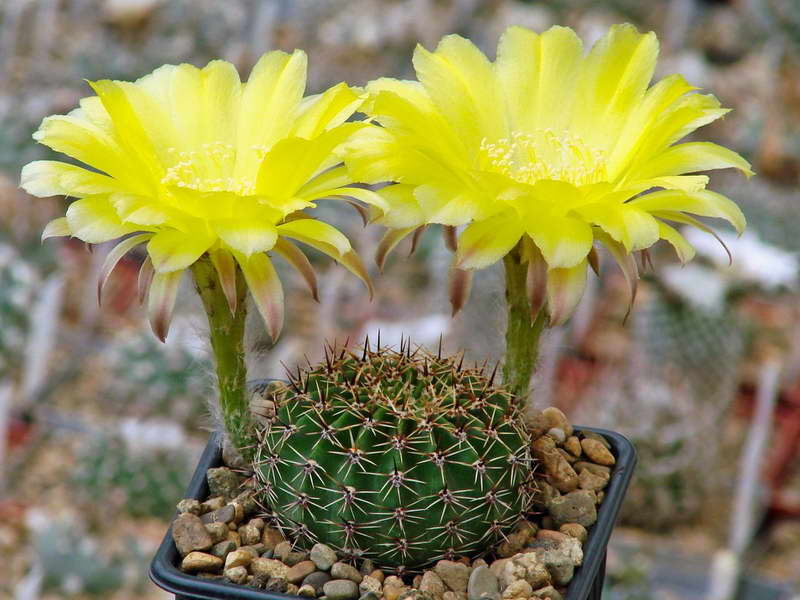

A crumb no more than 10 cm high. The stem of the ball eventually stretches a little in length. The ribs are pronounced, spines stick out from the halo. The shade of flowers is sunny yellow.
Description: A single cactus or with many lateral processes. This species shows great variability. Stems: dark green globular or elongated, reaching a height of 15 cm and a diameter of 4 to 10 cm or more. Ribs: 14 to 15 with sharp edges, separated by deep grooves. Areoles: brown on young plants. Spines: 8 to 10 rays, distinct, radial about 1 cm long, directed outward, usually 4 central spines, 2 to 4 (-6) cm long.One to four central spines are thicker, sometimes flat, about 3 cm (up to 6 cm) and brown to black with yellow tips. Flowers: (almost 10 cm) Long. They are usually lemon yellow and bright yellow on the inside, but this species also has white, pink, or red flowers. It blooms in waves in late spring and sometimes in summer. The buds are covered with long, silky hairs and grow laterally from the center of the stem. The tube is slightly curved, funnel-shaped, thin and greenish-white, with pale green scales, red at the base, with white and black fluff.
Echinopsis hook-nosed Echinopsis ancistrophora
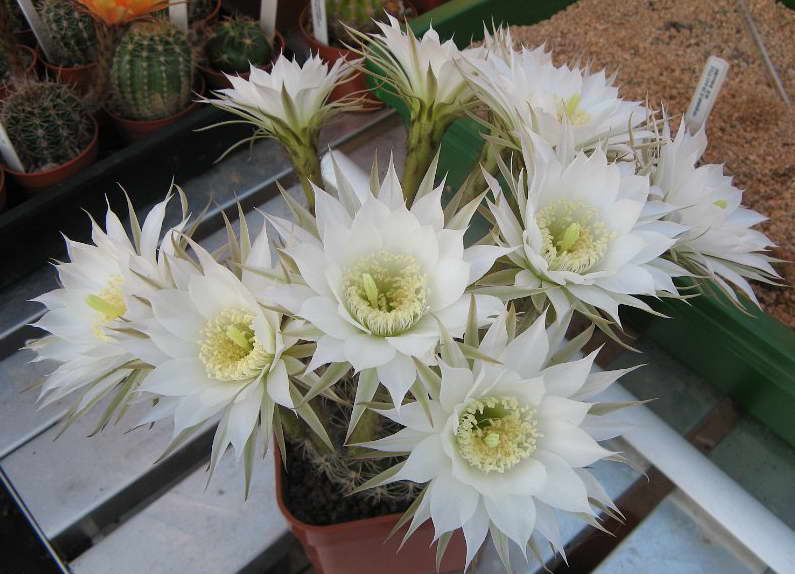

A flattened ball up to 6 cm high looks more like a shoot rather than an adult plant. The body is ribbed with spines about 1.5 cm long. Flowers are yellow, orange, white.
Echinopsis chamecereus Echinopsis chamaecereus
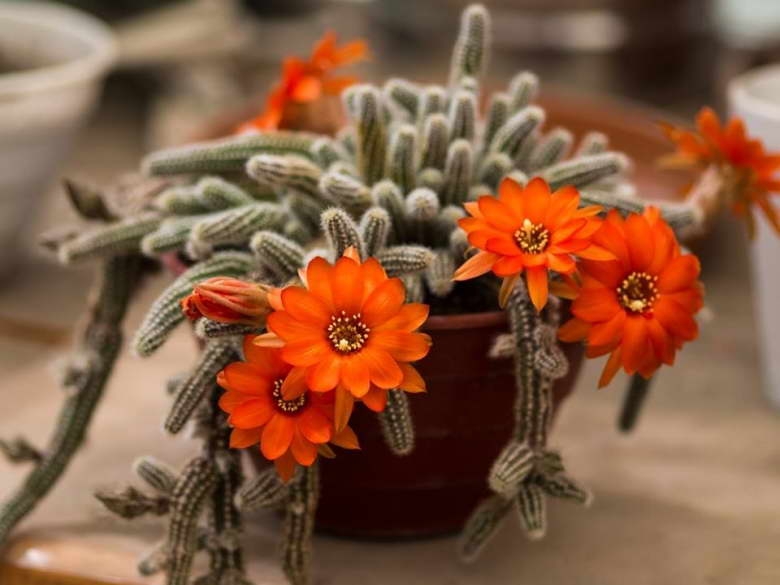

View with creeping shoots. They are numerous, it seems that many thorny "sausages" hang from the edges of the pot. The edges are poorly expressed. The skin is light green, but under intense light it takes on a purple hue. The flowers are red.
Description: The peanut cactus, Echinopsis chamaecereus (probably best known by its old name Chamaecereus silvestrii), is a very popular cactus with many crowded finger-like stems. Indoor plants can grow up to 15 cm in height and 30 cm (or more) in width.
Stems: Pale green, finger-sized, initially convex, growing up to 10 cm in height, 1.2 cm in diameter, up to 15 cm in length. As cacti age, they eventually become woody and thornless. Ribs: 8 to 10. Spines: 10 to 15 soft white bristles, 2 mm long.Flowers: orange-red, about 5 cm in diameter, usually appear in abundance from an early age of the plant. Bloom season: several times in late spring and early summer.
Echinopsis tube-flowering Echinopsis tubiflora
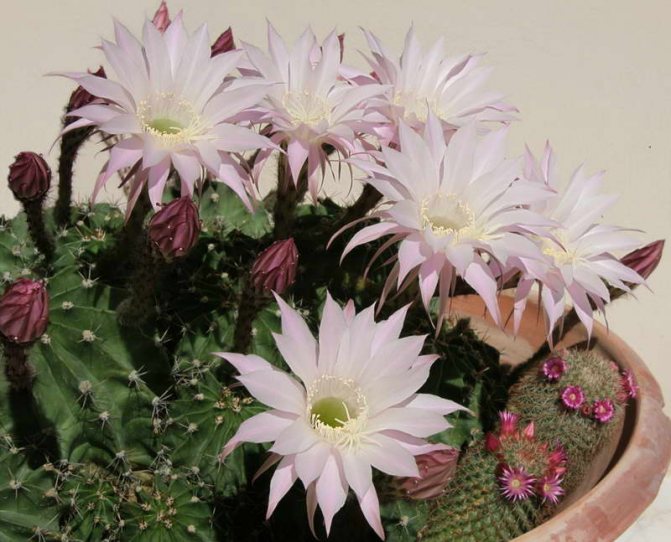

Echinopsis tube-flowering photo of flowering
The rounded stems take on a cylindrical shape as they grow. The ribs are separated by deep indentations. Long yellow spines are darker towards the top. The flowers are white with a pink undertone.
Echinopsis Calochlora Echinopsis Calochlora
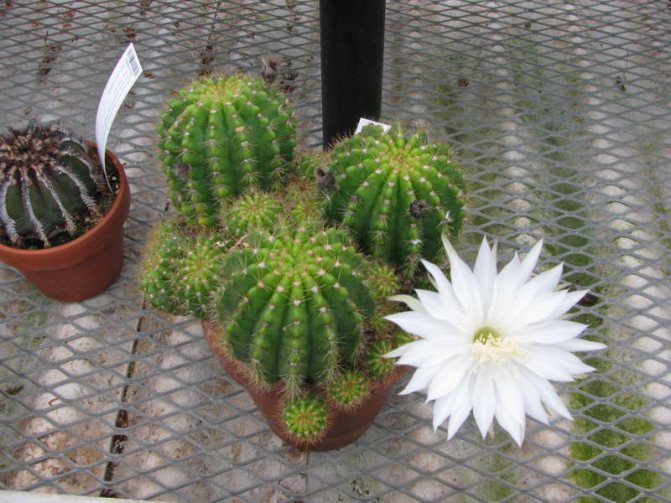

It has a spherical shape, stretching upward, cylindrical in the process of growth. The apex is depressed, the stem has pronounced vertical ribs, on which there are frequent areoles with sharp spines. It blooms with snow-white large flowers with long pointed petals, the middle is yellow, multiple white stamens with large white anthers.
Echinopsis Bakeberg Echinopsis backebergii
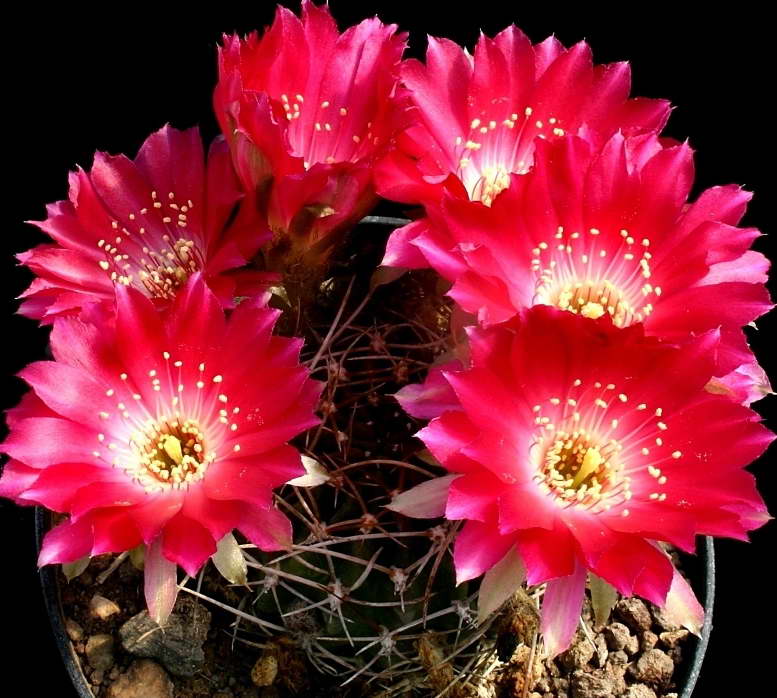

Description: Echinopsis backebergii is a small species of cactus with pronounced flowers. Because of their typical Lobivia floral structure, they are commonly known as Lobivia backebergii. It is a highly variable species and has received many names (like most Lobivia) with a few controversial varieties and subspecies. View: This is a spherical perennial succulent stem that grows individually, but also abundantly releases lateral shoots at the base, old plants can form whole islands. Stem: spherical at first, becomes cylindrical with age, about 4-5 (-7) cm in diameter. Epidermis pale green to grayish green. The top is somewhat depressed. Ribs: 13-19 sharp, more or less spiral, notched, incised above the areoles.
Areoles: at first oval, with dull white pubescence, at a distance of 1-1.5 cm. Spines: 1-11 variable, unequal, not always differentiated as central and radial Radial spines: 3-7 (-11) short, about 4 -50 mm long, slender, curved backward, at first pale reddish brown, yellow or amber, later gray, sometimes hooked at the tips.
Central spines: absent or sometimes 1 to 3 cm longer, darker with a black tip. Flowers: large, daytime, growing on the side of the stem tips, funnel-shaped, very bright from light to dark carmine red or purple, often with a bluish tint and white necks, 4-9 cm long, 7.5-9 cm in diameter, The tube is relatively thin, 4-7 mm in diameter. The petals are lanceolate.
Fruit: About 1.5 cm long, brownish-green to brownish-red, semi-dry cleavage vertically or horizontally. Seeds: relatively large, black, finely rough.
Basic signs
Echinopsis, which in the first years of life resembles a hedgehog and that is why it bears the name of this cute animal, is the most demanded genus of exotic thorns among the world community of flower growers.
IMPORTANT! The first specimens of cacti that arrived in Europe belonged precisely to the Echinopsis genus. And most often the first in the collections of beginners - amateurs is the same "green hedgehog".
The description of a cactus within a taxonomic unit varies considerably.
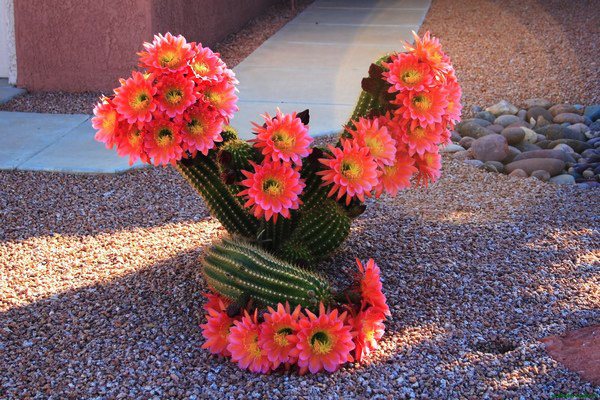

Although there are similar features:
- The presence in young specimens of a spherical stem of all shades of green with a sheen formed by smooth or bumpy ribs is considered characteristic. Symmetry is evident. Over time, the cactus takes on a somewhat elongated shape (from a few centimeters in culture - up to 2 meters in natural conditions).
- The presence of fluffy areoles with sharp, more or less long spines of varying hardness are mandatory for these cacti. Each areola contains within one and a half dozen skewers. Flower tubes begin to form from them.
- Flowering can occur as early as 3-4 years of age. The formation of peduncles is possible throughout the growing season. The opening of the buds occurs at night or in the morning, and the lifespan of each flower is no more than 3 days.At a time, about 25 open corollas can be counted on one stem, but this is on age cacti.
- The plant forms a long (three tens of centimeters) flower tube with hairs in the middle of the stem, on which a large (up to 15 cm) single funnel-shaped flower opens up. The corolla consists of several layers of yellow, white or pink-red petals. Several varieties have a pleasant aroma.
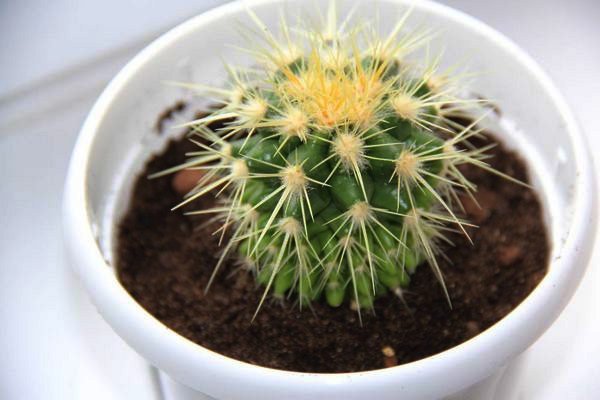

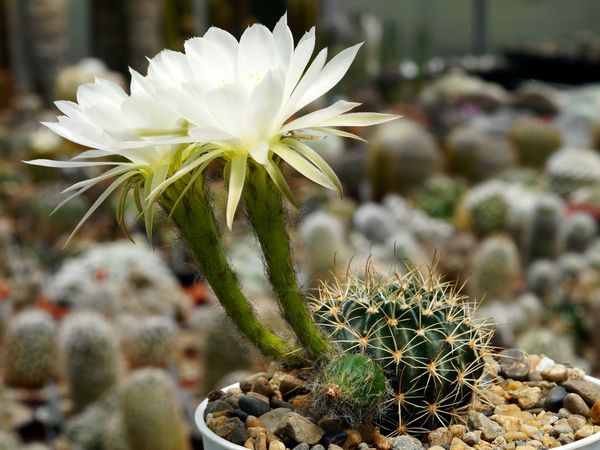

INTERESTING! For the beauty of the flowers, the cactus received another name - "prickly lily".
- In many collections, Echinopsis can be found as a base (rootstock) for other types of cacti.
- Echinopsis is distinguished among many plants for its wonderful and at the same time healing medicinal properties of its pulp. It has antibacterial properties, helps in the treatment of cardiovascular, gastric diseases, arthrosis, hypertension and much more.


Care
Lighting, temperature, humidity and watering
The homeland of Echinopsis is warm Latin America; some species of this cactus are also found in the foothills of the Andes. The climate there is hot, but in winter it can be cool - the temperature can drop to 7-8 degrees. Therefore, the cactus loves a dry, hot climate in summer, and in winter it is better to place it in a place where it will not be too warm.
- Echinopsis likes the sun: both direct rays and diffused light, so you can safely leave it even in the heat on the southern window, only slightly shading. In winter, it is necessary to lower the temperature, but it is not necessary to remove the cactus in the shade. It is best to place the room echinopsis in a cool room, for example, on an unheated loggia.
- Echinopsis is not watered in winter. Abundant watering and coolness can provoke rot on the roots of this flower. In the spring, when the cactus blooms, and in the summer, the plant needs to be watered abundantly, but care must be taken that moisture does not stagnate in the pot.
- Echinopsis does not like too humid air, so there is no need to spray the plant, although it is possible to bathe the cactus in the summer, when the plant has already faded. Taking a shower will help freshen up your flower and wash off the dust, but it is still better to cover the ground with a film or a bag so as not to accidentally flood the echinopsis.
- In summer, the flower will not be damaged by the fresh air, so you can take it out to the balcony or terrace.
Soil and pot
Echinopsis likes a nutritious, slightly acidic soil with good water permeability. The roots of the flower are quite powerful, but they do not go deep, but are located along the surface. Therefore, choose a pot that is shallow, but wide enough - more than the size of a cactus. Fill the pot a third with drainage. And, of course, make sure that there are holes at the bottom of the prepared pot for water outflow.
For echinopsis, ready-made soil for cacti, which can be purchased at the store, is suitable, but you can also prepare the necessary soil yourself. For this you need:
- leaf humus (2 parts);
- peat (1 part);
- coarse sand or perlite (1 part);
- charcoal (will help prevent root rot) (0.5 part).
Transfer
Take care of your hands when transplanting Echinopsis and other thorny cacti. Wear protective gloves to avoid pulling the thorns of your favorite flower out of your palms and fingers.
The cactus does not like transplanting, it has very delicate roots that can be easily damaged. Therefore, if you are going to transplant echinopsis, then it is best to transplant it, transferring it to a new pot along with a lump of earth. The soil in a new pot, and in a flower pot, should not be wet, the plant can be watered only one and a half to two weeks after transplanting. By this time, its roots should be restored if you accidentally injured them.
A young plant may need to be transplanted once every 2-3 years, and an old plant should be transplanted even less often - once every 4-5 years.
Useful video
Reproduction
Cacti can reproduce in three ways:
- seeds
- kids
- cuttings
Seed propagation
It is convenient to propagate echinopsis with seeds, if you want to get its rare variety, you are not too lazy to wait for shoots and take care of seedlings. Sowing echinopsis is best timed to coincide with the spring warming - by March, April.
- Prepare a bowl that is not too large, with drainage and damp soil;
- sow seeds without dripping;
- you can lightly spray them from a spray bottle;
- cover with foil or glass and put in a warm place;
- open the pot several times a day and ventilate the seeds, removing excess condensation from the film or glass;
- small echinopsis should appear somewhere in 2-3 weeks;
- young plants can be transplanted in 2-3 months, when thorns grow.
Reproduction by children
A cactus usually grows several children on its trunk. The grown baby must be carefully broken off from the mother plant. Then dry it for a few days, and plant it in moist soil.
Usually, children take root quite easily, but it is believed that cacti propagated in this way lose their varietal characteristics and bloom very rarely.
Cuttings
This method is also called rejuvenation of an old plant. If your echinopsis is already 4-5 years old, you can rejuvenate it by cutting and rooting its upper part. It is better to cut the plant in spring.
For this you need:
- prepare a pot of soil and small stones or coarse sand;
- a sharp thin knife, it is best to take a clerical knife, and alcohol for it;
- some ash;
- protective devices: gloves and pliers to protect hands from injury from thorns.
It looks, of course, barbaric - to cut a large cactus in half, but there is nothing wrong with this procedure. It will be useful for an old plant; after such rejuvenation, the flowers will become more magnificent and brighter. And sometimes a cactus gets sick, and it can only be saved in this way.
- Wipe the knife with alcohol;
- grab the plant with tongs or gently hold it with a gloved hand;
- carefully cut off the top of the cactus with a knife;
- dry the cut off crown for a few days, and then put it in a pot on the pebbles, cut down;
- for the mother plant, you need to sprinkle the cut with ash;
- the pot with the handle must be removed to a cool place, slightly shading;
- on the cut, the cactus will begin to grow children, which can later also be seated.
How to make echinopsis bloom
Yes, few people have seen blooming echinopsis. But to make the plant bloom - maybe even a beginner in floriculture. The most difficult condition for a cactus to bloom is its proper maintenance in winter. At this time of the year, you need to stop watering it and take it to a cool place. But, often, in warm apartments there is no way to provide the desired temperature, therefore, having overwintered in a warm room, Echinopsis will start raising children, but it will not bloom.
But if you have a cool loggia, try getting flowers from your cactus. Let its flowers be short-lived, but very beautiful. And without a doubt, this sight is worth a little tinkering with your echinopsis.
- First, remember how you purchased your cactus. If you planted it with seeds or bought it from a store, then there is every chance that the plant will bloom. But if you have a baby from a cactus that has never bloomed in its life, then most likely your plant will not bloom either.
- Provide your cactus with the correct dormant period from October to March: low temperatures (7-10 degrees) and no watering.
- With the beginning of spring, take the cactus out to a warm place. You can feed it with a special cactus fertilizer from the store.
- There should not be a lot of extra children on a cactus - the plant will spend energy on their growth, and not on flowering. It is better to break off the excess processes.
- During spring growth and when buds have appeared, the flower cannot be transferred from place to place and the position of the echinopsis in the sun cannot be changed, as this can lead to the buds falling off.
- Young plants bloom brightly and luxuriantly. Not too bright and multi-layered flowers in adult cacti.
Most often, Echinopsis is affected by rot of the roots or trunk, with excessive watering in the cold season. Rot is difficult to fight. Try to save the plant by breaking off the side children or cutting off the areas affected by rot, and try to root the surviving ones.
Sometimes, a mealybug or spider mite can settle on a flower, less often scale insects appear. These pests need to be dealt with using special products purchased in the store.
> "Thorny Lily" is the name of the Echinopsis cactus
Diseases and pests
The health of these small cacti is excellent, but indoor specimens can get sick if the microclimate of the room does not suit them or there is no competent care. Most often they suffer from rot, bacterial or viral diseases.
A flower can be saved from fungal ailments with the help of fungicides. Most often it makes no sense to treat ailments caused by bacteria or viruses; it is better to dispose of the affected flowers so that they do not infect healthy plants.
Pests disturb thorny succulents infrequently, but growers can still encounter worms, red spiderwebs, nematodes and scale insects. If the aerial part is damaged, the parasites should be removed with warm water and treated with a chemical. If the pest has wound up in the root system, then the cactus needs a transplant with the obligatory examination of the roots and the removal of the affected parts. The rhizome is treated with a solution of potassium permanganate, and the soil is spilled with a suitable insecticide.


1. Seven Secrets of Success:
| 1. Growing temperature: in spring and summer, the flower is kept at a temperature in the range of 18 - 24 ° C, the cool dormant period should take place at a temperature of 8 - 10 ° C. |
| 2. Lighting: the flower can take sun baths in the morning and evening, but in the warm season it should be in the shade during the daytime. |
| 3. Watering and humidity: in spring and summer, abundant, but rather rare watering should be replaced by cautious in the cold season. The air humidity should not be increased. |
| 4. Features of the: Echinopsis is one of the most unpretentious and at the same time easily and abundantly blooming cacti at home. |
| 5. Priming: nutritious and loose soil with a sourish pH. The soil should contain a large amount of river sand or stone chips, Echinopsis transfers nutrient-poor soils. |
| 6. Top dressing: in warm months, regular fertilizing with mineral fertilizers for cacti - once a month. In winter, fertilization is stopped and resumed only with the beginning of new growth in spring. |
| 7. Reproduction: vegetatively - by rooting cuttings in spring and summer, generatively - by sowing seeds in spring. |
Botanical name: Echinopsis.
Family... Cactus.
Echinopsis cactus - origin... South America.
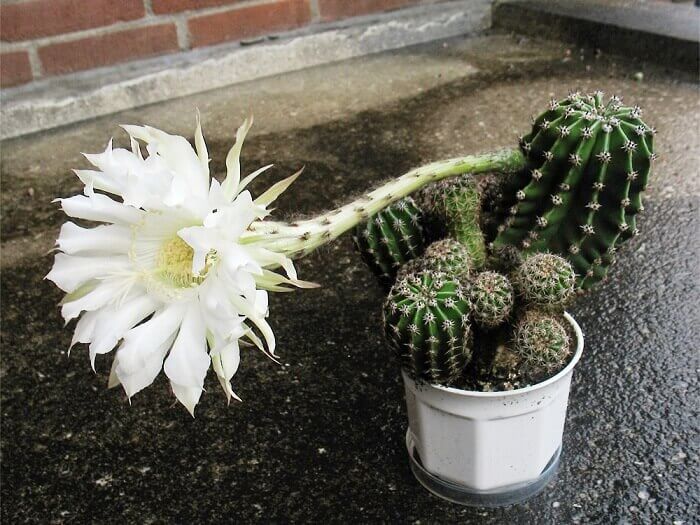

Description... An extensive and extremely variable genus of cactus, containing approximately 100 species. Echinopsis can be short, round-shaped plants or large tree-like cacti. Stems are globular, dark green, often becoming cylindrical with age. Lateral shoots often appear in many plants. The stems of mature plants are often woody and covered with brown bark. Ribs deep, well defined, vertical. The spines are short, light. Echinopsis is distinguished by gorgeous, large, fragrant flowers of various shades. The flower tubes are tall, covered with scales, open in the evening hours and wither during the day. The flowers have a very delicate, delicate aroma. The range of colors is very diverse and includes white, pink, red, yellow, orange, salmon shades. There are echinopsis with yellow stems that lack chlorophyll.


Height... Echinopsis flower grows slowly and its final height depends on the specific species.
Photo gallery
Photo gallery
A truly mesmerizing miracle of nature, which delights with the combination of the "thorniness" of the stem and the tenderness of the flower.
Types and names grown at home
Most of the cacti growing on windowsills and classified as one or another type of Echinopsis, in fact, are hybrids of this genus, difficult to taxonomically define. But this does not harm their beauty. A number of species have nevertheless remained unchanged.
Echinopsis sharp-edged (Echinopsis oxygona)
A distinctive feature of the cactus is a large number (up to a maximum of 14) of pointed, sometimes bumpy ribs on a juicy, green ball of the stem.


The ball can stretch up to 30 cm, gaining in a circle no more than a quarter of a meter. On the tops of the faces, fluffy white areoles are slightly deepened, bearing 1-7 central (0.4 cm) and up to 15 accompanying (about 15 mm) spines.
Flowers on a long tube (slightly more than 20 cm) in various shades of pink.
Echinopsis eyriesii
The Echinopsis eirieza cactus is a spherical stem, assembled from 11 - 18 facets of a dark shade of green. From the light fluff of round areoles, short (only 2 cm) sewn spines are slightly visible. A characteristic feature is the presence of multiple processes.
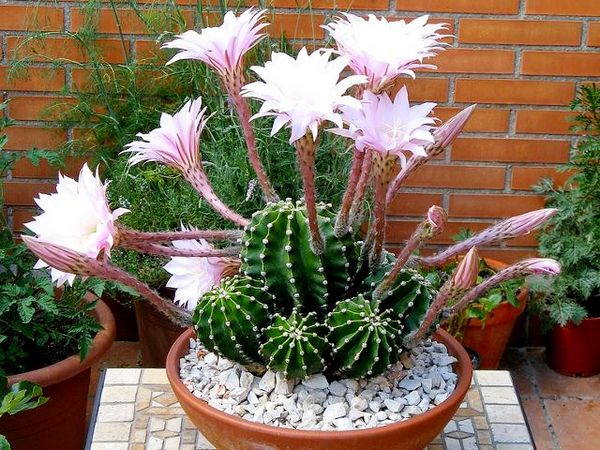

The cactus blooms with white or pinkish corollas, on the petals of which, closer to the center, densely pink lines are occasionally drawn. The long flower tube grows up to a quarter of a meter.
Echinopsis white-flowered (Echinopsis leucantha)
The stem of white-flowered Echinopsis is colored in a dark green tone with a grayish tint. Its shape can be round or resemble a small cylinder, which is due to the characteristic parameters: with a height of up to 40 cm, the girth of the stem is no more than 12 cm.
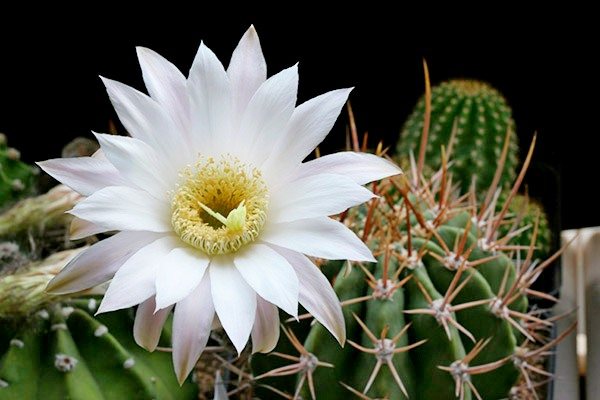

Usually 14 obtuse, tuberous edges are covered with elongated yellowish areoles. The areola ovals contain a single main (up to 10 cm) and 10 pieces of lateral (2.5 cm) spines. All of them are thick, curved, of a pleasant brown shade.
The snow-white corolla of a cactus is formed by several tiers of lanceolate petals.
Echinopsis mamilosis (Echinopsis mamillosa)
The cactus is beautiful not only in flowering state - E. mamylose itself is distinguished by its elegant shape and compact size.
Having a single stem no higher than 30 cm, the specimens are balls slightly pressed down from above. The ribs are sharp, in the amount of 13 to 17 pieces, painted in dense green.


On distinct tubercles of the edges of the balls of the areoles, yellow spines with brown tips peep out. The length of all the thorns is 1 cm, but the 4 central ones look like a thick awl, and the side ones are thinner, there can be up to 12. Because of the color of the needles, the cactus has a golden shine.
It blooms with pink or white buds. Corollas sit on small curved tubes (about 15 cm).
Echinopsis golden (Echinopsis aurea)
Young specimens of Echinopsis golden look like miniature balls. But even in adulthood, the cactus does not increase in size too much, representing a sample of miniature - stretching a little in height, the plant hardly reaches 10 cm. The stem looks like a green column flattened from above.
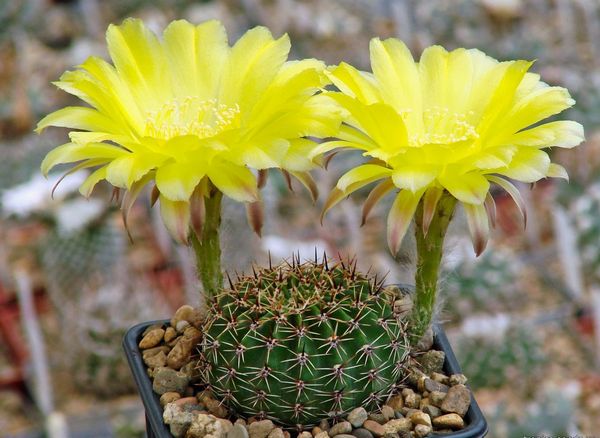

Gives multiple basal shoots, on each of which about 15 protruding faces can be counted. The brown areolas are very closely spaced. The spines protruding from them (up to 4 pieces in the center with a height of 3 cm and about 10 radial ones, reaching 10 cm) are so densely intertwined that they cover the cactus with a brown-gold net.
Photo gallery
Echinopsis - flowering
Cactus flowers open at night, as in natural conditions this is the time for pollination by bats and moths. Blooming echinopsis pleases the eye for only 1-3 days. The duration of flowering is determined by the air temperature, the number of buds is the age and condition of the plant. Adults can grow up to 25 flowers at a time. The length of the funnels is up to 30 cm, and the diameter is up to 15 cm. The kidney can easily be confused with a baby at first. In the upper / middle part of the stem, a small fluffy ovary (on the shady side) grows in a halo, which turns into a tube flower in a few days.
Echinopsis cactus blooms with white, pink, purple, yellow, orange, red flowers.Flowers have many petals. The funnels are covered with fine hairs inside. The flower has a large number of pistils with white or yellow light pollen. The peak of flowering of a cactus is the seventh-eighth year of life, it begins to bloom in the third year. When the pet gets old, the flowers become faded, it is rejuvenated: the top is cut off, left for two weeks in the fresh air, and then planted in wet sand until the roots appear.
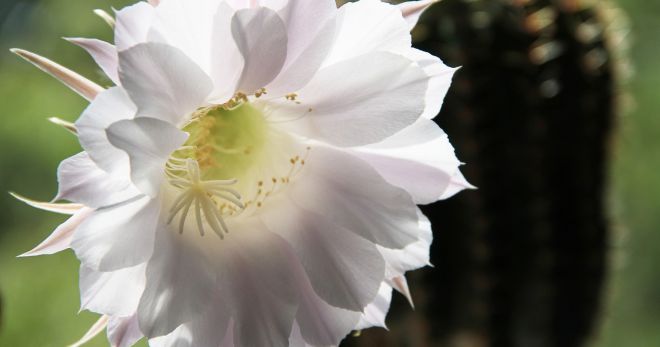

How often does Echinopsis bloom?
Often, the Echinopsis cactus in bloom pleases the owners with its delicate aroma. You can enjoy the wonderful smell in summer. Sometimes the buds begin to tie in the spring. With proper care (watering and wintering), flowers appear every year. The duration of flowering can be up to six months. It happens that Echinopsis does not bloom for a long time. The reason lies in the inappropriate temperature conditions. The plant needs to provide hot summers and cold wintering.
Photo
Below are photos of a cactus of the Echinopsis species
Features of growing and care
Like most cacti, Echinopsis is unpretentious. But improper care leads to a lack of flowering.
- Lighting. Prefers intense light, stretches when it is lacking. Reacts neutral to the bright sun.
- Temperature. In the warm season, they adapt well to the conditions of the apartment. Optimum performance is 22-27 ° C. Peace and coolness is needed in winter. The temperature is lowered to 6-12 ° C.
- Watering. In warm weather, watered 2-3 days after the soil surface dries. In winter, it does without watering, subject to low temperatures. If the temperature is above 12 ° C, water it once every 1-1.5 months.
- Humidity. The required amount of moisture is contained in the fleshy body of the cactus. Indifferent to dry air, does not need spraying.
- The soil. Use ready-made soil for cacti. The optimum pH is 6.
- Top dressing. In the growth and flowering phase, it is recommended to introduce special preparations for cacti. Do not fertilize in winter.
- Transfer. In early spring at intervals of 2-3 years. In the first week after transplanting, watering is excluded. High humidity leads to decay of the root system.
Advice! If echinopsis does not bloom, try to heed the advice of experienced florists. Some recommend taking children for reproduction from a plant that has already bloomed. In winter, difficult conditions are created for the cactus - they are kept in the cold and practically without watering. Stimulates bud formation by starting feeding immediately after a dormant period.
Main types
Echinopsis sharp-edged (Echinopsis oxigona)
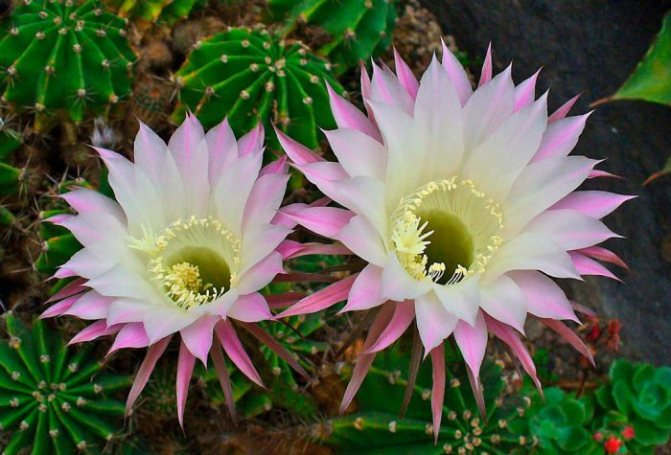

The spherical stem is green in color and can reach 5–25 centimeters in diameter. There are 8 to 14 rounded ribs, on which tubercles are sometimes located. Slightly recessed areoles are snow-white. The spines are slightly white, while there are from 1 to 5 central, needle-shaped and rather thick spines (they are absent on some cacti), and there are from 3 to 15 radial spines. Red-pink or pink flowers reach 22 centimeters in length. Green fruits reach 2 centimeters in diameter and 4 centimeters in length.
Echinopsis history
Indians of various tribes knew about the hallucinogenic properties of some cacti from ancient times and used these plants during religious ceremonies.
For the first time, mescaline was obtained from the peyote cactus on November 23, 1897 by the German chemist Arthur Heffter. Later, in 1919, Ernst Spaz synthesized mescaline chemically for the first time.
- In addition to peyote, mescaline is also found in San Pedro cacti, which are more popular than peyote because they grow faster than peyote.
- In 1927, the first scientific work on the effects of mescaline, Der Meskalinrausch, was published in Germany.
- In May 1953, Aldous Huxley first tries mescaline at a dosage of 400 mg and in 1954 publishes the essay "Doors of Perception" describing his experiment.
3. Varieties:
3.1. Echinopsis subdenudata - Echinopsis subdenudata
Small globular cacti with dull, green, slightly flattened stems.With age, numerous lateral processes may appear at the base of the stems. The ribs are vertical, deep, bearing sparsely spaced woolly areoles. The areoles contain very short, sharp spines. During the flowering period, tall flower tubes appear on the side of the stem, bearing large, single, white, less often pink flowers with numerous long petals at the top. Each cactus can have several peduncles. The flowers open at night and have a pleasant aroma.
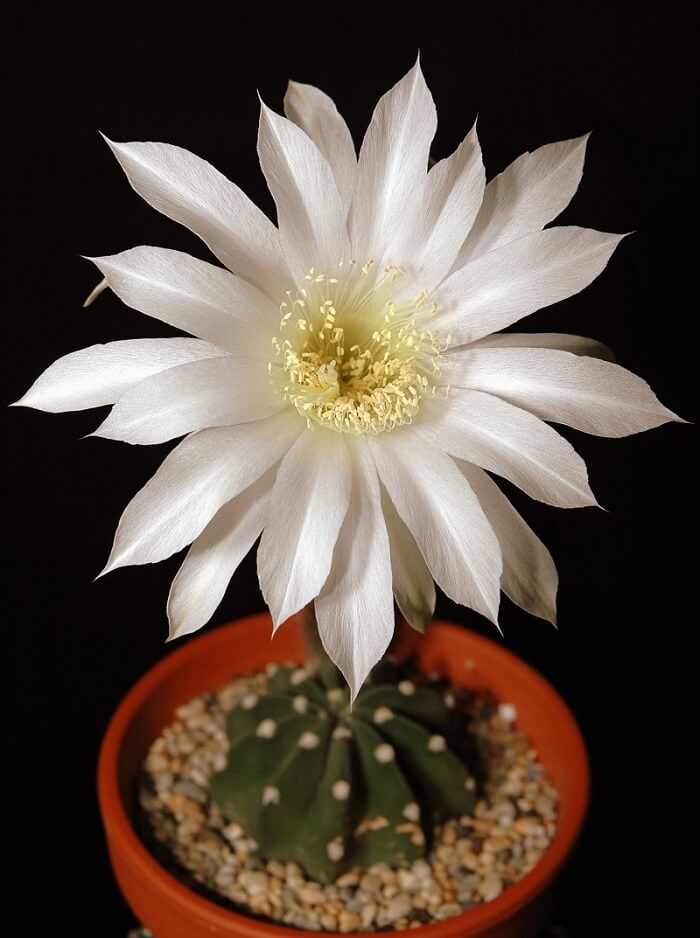

3.2. Echinopsis sharp-edged - Echinopsis oxigona
Rounded green cacti, forming large clusters with age. Sometimes the stems can take on a cylindrical shape. Shades of stems are varied and include green, bluish green, dark green. The ribs are numerous, deep, vertical, with pubescent halos. Each areola has several long, strong, light, straight spines. The flowers are funnel-shaped, on long flower tubes appearing on the side of the stems. An interesting feature of plants is that the inner petals of the flowers are often white, while the outer petals are lilac or pinkish. The flowers open at night and have a very pleasant aroma.
Features of the genus


Translated from greek its name means hedgehog... At the beginning of development, these cacti really look like curled up spiny hedgehogs.
Echinopsis have fleshy stems and a powerful root system. The roots are close to the surface. Their flowers are very large, located on a long pubescent stem. Some have a pleasant aroma.
Different species bloom from early spring to late autumn. Each flower lives in full bloom for only a day or two.
Number of colors on the plant comes up to 20-25 pieces... They form a red or yellowish fruit in the form of a ribbed barrel or ball.
They grow very quickly, the first flowers appear already in age 3 years... Varietals grow more slowly.
Views:
- Eirieza Dark green Echinopsis, spherical in juveniles and short-cylindrical in adult specimens. Height 20-22 cm, diameter about 15 cm.
Areoles are white-yellow, rounded. The spines are long. The flowers are elongated, white-pink. - Chilean Arboreal, branches at the base. The stem is cylindrical, elongated. Ribs with pronounced tubercles, low. Pale yellow, one to two centimeters long. The central thorn is 4-7 cm. The flowers are large, about 14 centimeters long.
- Pampana Stem spherical, 5-7 centimeters in diameter. Curved spines, up to 5 centimeters long. The flowers are red.
- Shilya
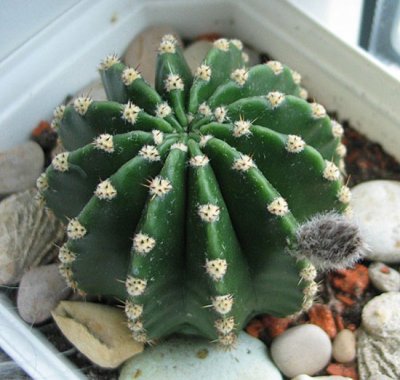

Stem height 5-6 centimeters. About 14 ribs.
Areoles and spines are white. Flowers are fiery red, erect. - Klinger's stem is spherical at the top, cylindrical at the base. Spines are long, grayish, located on light pubescent areoles.
Flowers with multi-tiered petals, snow-white with dark tips. - Dumat The stem is undersized, rounded, with pronounced ribs. The spines are small. The flowers are lilac-white.
- Sharp-edged Spherical, somewhat elongated stem, diameter 20-25 cm, length 15 cm. Covered with pointed ribs with large areoles. The flowers are purple-red. It blooms at night, in May-June.
- Mammillose kermezin An exquisite form of Echinopsis cactus, single stem, about 30 centimeters. Areoles are rounded with yellow subulate spines. Pink flowers growing in tiers.
- Tubular Green, first spherical, then cylindrical stem. The spines are brown, black at the tips. It blooms with large, funnel-shaped, white flowers on a twenty-centimeter stem.
- Ancystrophe Green small stem in the form of a flattened ball. Covered with pronounced tubercles and hooked spines. The flowers are white.
- Subdenudata


It differs from other species in the absence of thorns. Spherical flattened stem 20 centimeters high and 10 centimeters in diameter.
Flowers are 10 cm. Blooms at a young age. - Golden Stem spherical at the beginning of growth and cylindrical in the adult. Pronounced ribs covered with centimeter spines.
The flower is yellow-orange. Withstands light frosts. - Bakeberg Round-cylindrical stems, height up to 7 centimeters. The flowers are bright pink.
- Bridges grows in groups of 4 to 6 trunks. Tall, about 40 centimeters stems, 10-13 centimeters in diameter. The flowers are white.
- Hamecerus Forms numerous stems hanging from the edge of the pot. It blooms in spring with bright orange flowers. Frost resistant.
- Bright green echinopsis Globular stem about 9 centimeters in diameter. Rare radial, numerous central needles.
- Coquimban Cylindrical, elongated stem. In nature, it grows up to one meter. Forms dense thickets.





